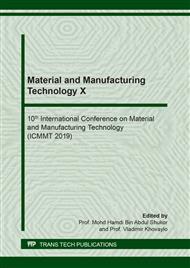[1]
A. Martín and A. Escarpa, Trends in Analytical Chemistry Graphene : The cutting – edge interaction between chemistry and electrochemistry,, vol. 56, p.13–26, (2014).
DOI: 10.1016/j.trac.2013.12.008
Google Scholar
[2]
B. Zhang, Y. Wang, and G. Zhai, Biomedical applications of the graphene-based materials,, Mater. Sci. Eng. C, vol. 61, p.953–964, (2016).
Google Scholar
[3]
G. Burwell, S. Teixeira, A. Castaing, and O. Guy, Synthesis and characterization of ( 3-aminopropyl ) triethoxysilane- modified epitaxial graphene,, vol. 806, p.95–102, (2015).
DOI: 10.4028/www.scientific.net/msf.806.95
Google Scholar
[4]
S. Teixeira, R. S. Conlan, O. J. Guy, and M. G. F. Sales, Novel single-wall carbon nanotube screen-printed electrode as an immunosensor for human chorionic gonadotropin,, Electrochim. Acta, vol. 136, p.323–329, (2014).
DOI: 10.1016/j.electacta.2014.05.105
Google Scholar
[5]
L. Hou, Y. Cui, M. Xu, Z. Gao, J. Huang, and D. Tang, Graphene oxide-labeled sandwich-type impedimetric immunoassay with sensitive enhancement based on enzymatic 4-chloro-1-naphthol oxidation,, Biosens. Bioelectron., vol. 47, p.149–156, (2013).
DOI: 10.1016/j.bios.2013.02.035
Google Scholar
[6]
S. Rauf, G. K. Mishra, J. Azhar, R. K. Mishra, K. Y. Goud, M. A. H. Nawaz, J. L. Marty, and A. Hayat, Carboxylic group riched graphene oxide based disposable electrochemical immunosensor for cancer biomarker detection,, Anal. Biochem., vol. 545, p.13–19, (2018).
DOI: 10.1016/j.ab.2018.01.007
Google Scholar
[7]
S. Li, Z. Wang, J. Jia, C. Hou, X. Hao, and H. Zhang, Preparation of Hydroxyl and (3-aminopropyl) Triethoxysilane Functionalized Multiwall Carbon Nanotubes for Use as Conductive Fillers in the Polyurethane Composite,, (2016).
DOI: 10.1002/pc.24054
Google Scholar
[8]
Y. Zeng, J. Bao, Y. Zhao, D. Huo, M. Chen, Y. Qi, M. Yang, H. Fa, and C. Hou, A sandwich-type electrochemical immunoassay for ultrasensitive detection of non-small cell lung cancer biomarker CYFRA21-1,, Bioelectrochemistry, vol. 120, p.183–189, (2018).
DOI: 10.1016/j.bioelechem.2017.11.003
Google Scholar
[9]
T. T. N. Lien, Y. Takamura, E. Tamiya, and M. C. Vestergaard, Modified screen printed electrode for development of a highly sensitive label-free impedimetric immunosensor to detect amyloid beta peptides,, Anal. Chim. Acta, vol. 892, p.69–76, (2015).
DOI: 10.1016/j.aca.2015.08.036
Google Scholar
[10]
R. Montes, F. Céspedes, and M. Baeza, Highly sensitive electrochemical immunosensor for IgG detection based on optimized rigid biocomposites,, Biosens. Bioelectron., vol. 78, p.505–512, (2016).
DOI: 10.1016/j.bios.2015.12.059
Google Scholar
[11]
J. Kim, P. Seidler, L. S. Wan, and C. Fill, Journal of Colloid and Interface Science Formation , structure , and reactivity of amino-terminated organic films on silicon substrates,, J. Colloid Interface Sci., vol. 329, no. 1, p.114–119, (2009).
DOI: 10.1016/j.jcis.2008.09.031
Google Scholar
[12]
N. Siva, K. Gunda, M. Singh, L. Norman, K. Kaur, and S. K. Mitra, Applied Surface Science Optimization and characterization of biomolecule immobilization on silicon substrates using (3-aminopropyl) triethoxysilane (APTES) and glutaraldehyde linker,, Appl. Surf. Sci., vol. 305, p.522–530, (2014).
DOI: 10.1016/j.apsusc.2014.03.130
Google Scholar


